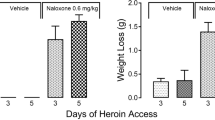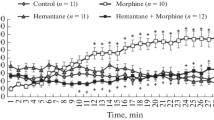Abstract
The abuse of benzodiazepines by narcotic addicts has been well documented. However, the pharmacological basis of this abuse is not clear. In this study the effects of different benzodiazepines (flunitrazepam: 0.5, 1 and 2 mg/kg; nitrazepam: 0.5, 1, 2.5, 5 and 10 mg/kg; diazepam: 0.5, 1, 2.5, 5 and 10 mg/kg; chlordiazepoxide: 0.5, 1, 2.5, 5 and 10 mg/kg; and triazolam: 0.5, 1 and 2 mg/kg) on the morphine withdrawal syndrome in mice have been compared. Drugs were administered 30 min before naloxone-induced withdrawal. All benzodiazepines tested induced similar changes in some of the signs of morphine abstinence: decreased jumping behavior and increased wet dog shake frequency. Jumping behavior was particularly decreased by triazolam and wet dog shakes were mainly increased by flunitrazepam and nitrazepam. Forepaw treading was reduced by flunitrazepam, diazepam and triazolam, increased by nitrazepam and not changed by chlordiazepoxide. Tremor was effectively reduced by diazepam but less reliably by the other benzodiazepines. Teeth chattering was reduced by flunitrazepam and diazepam. These results indicate that benzodiazepines can interfere with the expression of the morphine withdrawal syndrome.
Similar content being viewed by others
References
Antonelli T, Beani L, Bianchi C, Rando S, Simonatto M, Tanganelli S (1986) Cortical acetylcholine release is decreased and gamma-aminobutyric acid outflow is reduced during morphine withdrawal. Bri J Pharmacol 89:853–860
Ary M, Cox B, Lomax P (1977) Dopaminergic mechanisms in precipitated withdrawal in morphine-dependent rats. J Pharmacol Exp Ther 200:271–276
Baldino F, Cowan A, Geller EB, Adler M (1979) Effects of antipsychotic and antianxiety drugs on the morphine abstinence syndrome in rats. J Pharmacol Exp Ther 208:63–66
Berthold H, Borel JF, Fluckiger E (1989) Enigmatic action of ciclosporine A on the naloxone-precipitated morphine withdrawal syndrome in mice. Neuroscience 31:97–103
Bläsig J, Herz K, Reinhold K, Zieglgansberger S (1973) Development of physical dependence on morphine in respect to time and dosage and quantification of the precipitated withdrawal syndrome in rats. Psychopharmacologia 33:19–38
Bruno F, Ferracuti F (1982) Descrizione di alcuni casi clinici di abuso e di possibile dipendenza da flunitrazepam. Riv Tossicol Sperim Clin 12:125–152
Buccafusco JJ, Masshall DC, Turner RM (1984) A comparison of the inhibitory effects of clonidine and guanfacine on the morphine withdrawal in rats. Life Sci 35:1401–1409
Contreras E, Tamayo L (1985) Effects of ethylendiamine on morphine analgesia and tolerance-dependence in mice. Gen Pharmacol 16:529–531
Contreras E, Tamayo L, Quijada L (1979) Effects of GABA-transaminase upon some morphine effects. Neuropharmacology 18:309–313
Cooper SJ (1983) Benzodiazepine-opiate antagonist interactions in relation to anxiety and appetite. TIPS 4:456–458
Drummond DC, Turkington D, Rahman MZ, Mullin J, Jackson P (1989) Chlordiazepoxide vs methadone in opiate withdrawal: a preliminary double blind trial. Drug Alcohol Depend 23:63–72
Duka T, Wuster M, Herz A (1980) Benzodiazepines modulate striatal enkephalin levels via a GABAergic mechanism. Life Sci 26:771–776
Evans SM, Schwartz GE, Griffiths RR (1989) Zolpidam and triazolam in humans: behavioral effects and abuse liability. Abstracts of 28th meeting of American College of Neuropsychopharmacology, 161
Gibert-Rahola J, Maldonado R, Micó JA, Leonsegui I, Saavedra MC (1988) Comparative study in mice of flunitrazepam vs diazepam on morphine withdrawal syndrome. Prog Neuropsychopharmacol Biol Psychiatry 12:927–933
Gold MS, Byck R, Sweeny DR, Kleber HD (1979) Endorphin-locus coeruleus connection mediates opiates action and withdrawal. Biomedicine 30:1–4
Griffiths RR, Lamb RJ, Ator NA, Roache JD, Brady JV (1985) Relative abuse liability of triazolam: experimental assessment in animals and humans. Neurosci Biobehav Rev 9:133–151
Haefely W, Polc P (1983) Electrophysiological studies on the interactions of anxiolytics drugs with GABAergic mechanisms. In: Malik JB, Enna SJ, Yamamura HI (eds), Anxiolytics: neurochemical, behavioral and clinical perspectives. Raven Press, New York, pp 113–145
Hynes MD, Shearman GT, Lal H (1980) Alterations in brain GABA fail to influence morphine withdrawal body shakes. Brain Res Bull 5:805–808
Khana NC, Sharma SK (1983) Megadoses of vitamin-C prevent the development of tolerance and physical dependence on morphine mice. Life Sci 33 [suppl I] 401–404
Lee EHY, Wang FB, Tang YP, Geyer MA (1987) GABAergic interneurons in the dorsal raphe mediate the effects of apomorphine on serotonergic system. Brain Res Bull 18:345–353
Litt I, Colli A, Cohen M (1971) Diazepam in the management of heroin withdrawal in adolescent; preliminary report. Pediat Pharmacol Ther 78:692–696
Llorens C, Maitres M, Bardry M, Schwartz J (1978) Hypersensitivity to noradrenaline in cortex after chronic morphine: relevance to tolerance and dependence. Nature 274:603–605
Maldonado R, Daugé V, Callebert J, Villete J, Feger J, Fournié-Zaluski M-C, Roques BP (1989) Comparison of selective and complete inhibitors of enkephalin-degrading enzymes on morphine withdrawal syndrome. Eur J Pharmacol 165:199–207
Micó JA, Maldonado R, Saavedra MC, Leonsegui I, Gibert-Rahola J (1987) Comparative strategies in the development of morphine withdrawal behaviour in mice: effects of benzodiazepines and antidepressants. 1st Congress of Preclinical Strategies in Psychopharmacology, Paris
Marks J (1985) The benzodiazepine: use, overuse, misuse, abuse? MTP Press, Lancaster, England, pp 1–165
Marshall I, Weinstock M (1971) Quantitative method for assessing one symptom of the withdrawal syndrome in mice after chronic morphine administration. Nature 234:223–224
Nathenson G, Golden GS, Litt IP (1971) Diazepam in the management of the neonatal narcotic withdrawal syndrome. Pediatrics 48:523–527
Navaratman V (1982) Impact of scheduling drugs under the 1971 convention on psychotropic substances-benzodiazepines reappraised. United Nations Research and Training Centre in Drug Dependence, National Drug Research Centre. Univ. Science Malasy Minden, Penang, Malaysia
Nicolai P, Di Carlo M, Alfani F, Cerbo R, Smeriglio M, Borgo S, Cipriani E, Tarquini S, Malizia E (1981) La nostra experienza sull intossicacione acuta da flunitracepam. Riv Tossicol Sperim Clin 3:47
Sawynok J (1984) GABAergic mechanisms in antinociception. Prog Neuropsychopharmacol. Biol Psychiatry 8:581–586
Sivam SP, Ho IK (1983) GABAergic drugs, morphine and morphine tolerance. A study in relation to nociception and gastrointestinal transit in mice. Neuropharmacology 22:767–774
Sivam SP, Ho IK (1984) GABA in morphine analgesia and tolerance. Life Sci 37:199–208
Smith RB, Kroboth PD, Varner PD (1987) Pharmacodynamics of triazolam after intravenous administration. J Clin Pharmacol 27:971–979
Sugerman AA, Mikstal MW, Freymuth HW (1971) Comparison of prazepam and placebo in the treatment of convalescing narcotic addicts. J Clin Pharmacol 11:383–387
Tseng L-F, Loh HH, Wei T (1975) Effects of clonidine on morphine withdrawal signs in the rat. Eur J Pharmacol 30:93–99
Ushijima J, Mizuki Y, Yamada M, Glaving G (1985) Neuronal mechanisms involved in drug-induced jumping behavior in mice. Eur J Pharmacol 112:225–229
Valeri P, Martinelli B, Pimpinella G, Severini C (1989) Effects of dapiprazole, clonidine and yohimbine on the development of dependence and withdrawal behaviour in mice. Drug Alcohol Depend 23:73–77
Wei E, Loh HH, Way EL (1973) Quantitative aspects of precipitated abstinence in morphine-dependent rats. J Pharmacol Exp Ther 184:398–403
Williams D, Thorn B (1984) Opiate withdrawal behavior after focal brain stimulation. Pharmacol Biochem Behav 21:699–705
Woody GE, O'Brien CP, Greenstein R (1975) Misuse and abuse of diazepam: an increasingly common medical problem. Int J Addict 10:843–848
Author information
Authors and Affiliations
Rights and permissions
About this article
Cite this article
Maldonado, R., Micó, J.A., Valverde, O. et al. Influence of different benzodiazepines on the experimental morphine abstinence syndrome. Psychopharmacology 105, 197–203 (1991). https://doi.org/10.1007/BF02244309
Received:
Revised:
Issue Date:
DOI: https://doi.org/10.1007/BF02244309




